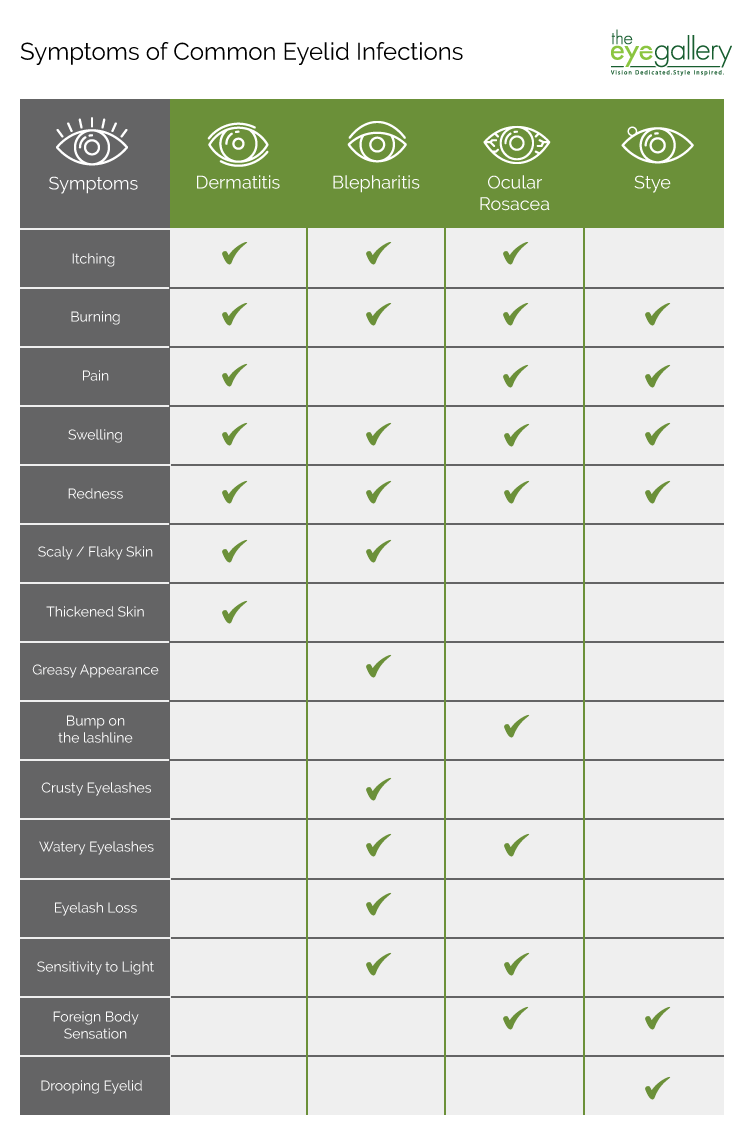Eye infections like pink eye are serious business. Most people know and respect that, which is great. But I don’t know that enough people understand the importance or possible severity of eyelid infections.
Your eyelids are exposed to a lot of heat and moisture, which creates an excellent environment for bacteria to grow. On top of the natural potential for infection, many people don’t take eyelid hygiene seriously, which makes them even more likely to develop an eyelid infection.
I see eyelid infections all the time, and in my opinion, we don’t talk about them nearly enough. Today, I’d like to rectify that. These are some of the basic facts you should know about common eyelid infections.
Blepharitis
Blepharitis is an inflammation of the eyelid. While it’s not necessarily an infection in its own right, it can stem from issues like staph infections or even head lice infestations. Although eyelid inflammation itself isn’t necessarily infectious, the condition causing the inflammation might be, so you should be careful to avoid touching the area.
Blepharitis is closely related to dry eye disease. In fact, some medical scientists have proposed merging dry eye and blepharitis into a single condition called Dry Eye Blepharitis Syndrome or DEBS.
When the eyelid becomes inflamed, the meibomian glands along the margins of the eyelids struggle to excrete oil properly. Without a thin layer of oil coating the surface of your tears, the tears evaporate too quickly. This premature evaporation causes the eyes to feel dry and irritated.
Symptoms
Symptoms of blepharitis include:
- Flaky skin on the eyelid
- Crusty debris on the eyelashes
- Dry eye
- Excessive tears
- Itching
- Redness
- Swelling
- Greasy eyelids
- Gritty sensation
- Sensitivity to light
Treatments
One of the most popular treatments for blepharitis is called BlephEx. It is an in-office treatment designed to clear debris from the lash line.
Eyelid hygiene is crucial in the treatment and management of blepharitis. In addition to BlephEx, you can also find certain lid wipes and cleansers that are specifically designed for your eye health. If you do not have access to these sorts of at-home treatments, some people find that baby shampoo on a cotton swab is gentle enough to help prevent flare-ups.
In some cases, your optometrist may treat your blepharitis with a topical antibiotic.
Dermatitis
The term dermatitis, again, does not refer specifically to infection. It is a word that refers to general skin irritation.
Dermatitis typically occurs due to irritants coming into contact with the skin (called contact dermatitis), genetic conditions like eczema (atopic dermatitis), or due to allergies (called allergic dermatitis).
There is also a type of dermatitis called seborrheic dermatitis. The medical community is somewhat divided on this condition and cannot quite agree whether it is a bacterial infection, a fungal infection, or not an infection at all.
There is evidence to indicate that both yeast and staphylococcus (the bacteria responsible for staph infections) bacteria could be partly responsible for seborrheic dermatitis.
Symptoms
Symptoms of eyelid dermatitis include:
- Thickened eyelid skin
- Itching
- Redness
- Loss of eyelashes
- Swelling
Treatments
The treatment for dermatitis depends on which type of dermatitis you are experiencing. Your doctor may prescribe a corticosteroid treatment to reduce swelling and inflammation. Your optometrist may also prescribe a topical or oral medication that suppresses your immune response in order to get the inflammation under control.
In the short-term, you may find moisturizing lotions without perfume or fragrances help soothe the itching and discomfort.
Ocular Rosacea
Much like blepharitis and dermatitis, ocular rosacea is a condition that develops due to the skin’s inflammatory response. Doctors do not currently have a definitive answer for what causes rosacea. However, research indicates that the condition is linked to bacteria as well as eyelash mites.
Sufferers of ocular rosacea are also quite prone to eye infections like conjunctivitis or pink eye.
Ocular rosacea can be triggered by a variety of factors, including everything from your environment to emotions like anger or embarrassment.
Symptoms
Symptoms of ocular rosacea include:
- Redness
- Itching
- Burning or stinging
- Dry eyes
- Excessive tears
- The sensation that something is stuck in your eye
- Swelling
Treatments
Ocular rosacea is not curable, however, it can be managed with the right medications. In most cases, ocular rosacea is treated with oral antibiotics, or sometimes, corticosteroids in the form of eye drops.
How Can I Tell What Kind of Infection I Have?

The symptoms of different eyelid conditions can be quite similar, which makes it difficult to determine what condition you are suffering from. However, it is best to leave the diagnosis up to your optometrist. If something seems abnormal about your eyelids, it is best to see your optometrist as soon as possible. They will make a formal diagnosis and provide you with the appropriate treatment.




